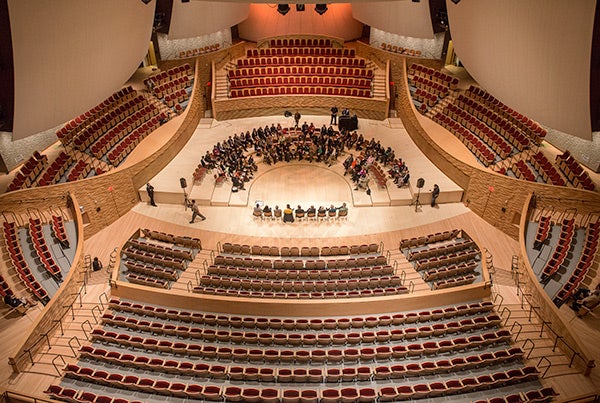|
January 9, 2013
Stanford's Bing Concert Hall opens this Friday with soundscape fanfare
The first notes on opening night will show off the advanced acoustic and technical systems of the new concert hall. By Robin Wander

Opening night for Stanford's Bing Concert Hall is this Friday, Jan. 11. (Photo: Linda A. Cicero / Stanford News Service)
A three-minute fanfare packed with sounds shaped and inspired by Stanford's Bing Concert Hall – including harbor horns, a Canadian icebreaker, music student assignments and even the hall's steel beams – will be the first music heard at the hall on opening night this Friday, Jan. 11.
Faculty at the Department of Music's Center for Computer Research in Music and Acoustics created the soundscape in response to the call for a ceremonial introduction to the evening program.
Similarly, the chimes called BingTones that usher audiences into the hall and signal the end of intermission were composed on a computer. "Why use standard chimes when we could invent them and customize them to the space, to our new hall?" said Jenny Bilfield, the artistic director of Stanford Live.
CCRMA faculty and staff have been involved in the design of the infrastructure and technical systems for Bing Concert Hall from the very beginning. Working with the Stanford project core team – Nagata Acoustics, audio/visual consultant Sonitus and Ennead Architects – they developed the 24.6 channel sound system tailored to the hall and intended to support a great range of music and performances (the fanfare will utilize a smaller version of the full multichannel system).
Sound montage
CCRMA faculty members Chris Chafe and Fernando Lopez-Lezcano are co-composing Fugue 1, the Bing fanfare for opening night, and Fugue 2, a longer fanfare for June 1 when the season closes with Beethoven's Ninth Symphony. Each fanfare is a montage of collected sound material that reflects the variety of the inaugural Stanford Live season in Bing.
"In building a program that was uniquely Stanford, and unlike what audiences would hear and experience elsewhere, we wanted to have a component of the program that would accentuate the acoustics and technical systems of the hall," said Bilfield.
With the fanfares, the audience will experience the space as a musical instrument both with, and without, live performers. "They will hear the dimensionality of the hall, stage to ceiling, sail to sail."
For his sound-collecting expedition, Lopez-Lezcano spent an hour above the cloud (the floating ceiling of Bing Concert Hall) with a digital recorder, carefully banging on anything that would make noise. Ladders, handrails, covers for the rigging motors and steel beams are all fodder for the final fanfare mix in both original and computer processed forms.
Chafe's search for sound took him a bit farther off campus. He was at a sound symposium in St. John's, Newfoundland, where he collected horn sounds from the Harbour Symphony and also the noise of a Canadian icebreaker.
Beacon of sound
"Bing looks like a beacon to me and it made me think of cathedral bells in the fog," said CCRMA staffer and designer of the BingTones Sasha Leitman about her inspiration for the sonic logo.
Leitman is a musician, artist and inventor who experiments with all kinds of sounds and admittedly pulled in the reins a bit on the "weird sounds" while composing the BingTones. In this case, some tradition seemed appropriate for the space.
"Sasha is a Stanford alum, and therefore has a very special and personal sense of the campus. Her BingTones fill the concert hall space beautifully, evoking a carillon, like the one at Hoover tower, but with some wonderful, additional texture and playfulness," said Bilfield.
Peter Bing (who, with his wife, Helen, donated $50 million to build the concert hall) didn't have to be told where the tone tune came from. He recognized the first four notes of Come Join the Band, the Stanford Band's original fight song, right away.
-30-
|